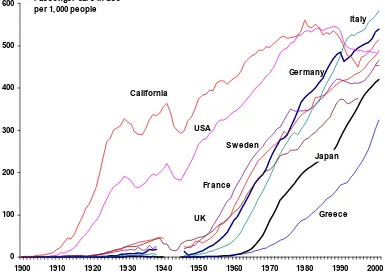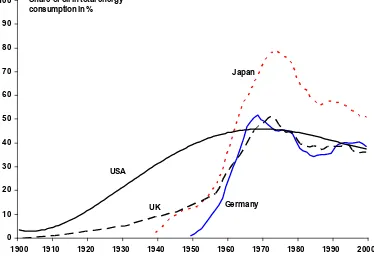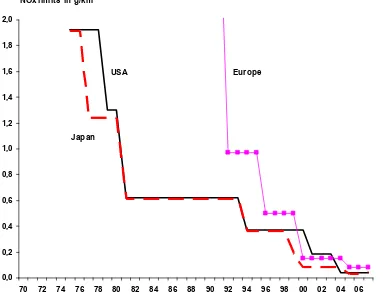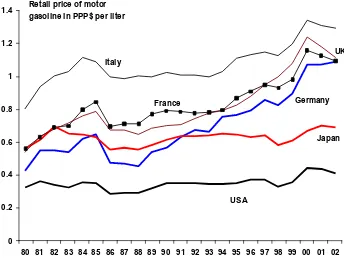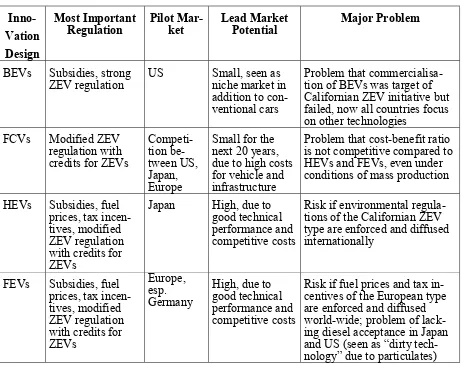National Environmental Policy and the Global Success of
Next-Generation Automobiles
Marian Beise, Research Institute for Economics and Business Administration, Kobe University, 2-1 Rokkodai, Nada-ku, Kobe-shi, 657-8501 Japan
Phone: +81 (0)78 803-7032, Fax: +81 (0)78 803-7059, e-mail: rian@rieb.kobe-u.ac.jp
Klaus Rennings, Centre for European Economic Research (ZEW) P.O. Box 103443, 68034 Mannheim, Germany
Phone: +49 (0)621 1235-207, Fax: +49 (0)621 1235-207, e-mail: rennings@zew.de
Abstract.
In this article, we identify the most crucial factors for the potential world market success of different alternative car designs: fuel cell vehicles (FCVs), hybrid electric vehicles (HEVs), battery electric vehicles (BEVs), and conventional fuel efficient vehicles (FEVs). We first assess which vehicle concept is favoured under which regulation regime. We suggest that the global success of a certain technology critically depends on the ability of a regional lead mar-ket to leverage and transfer its local success, through large cost reductions or the international diffusion of a pioneering environmental regulation for instance.
Although FCVs are still in the demonstration phase, the US has set the stage for a direct switch to FCVs. The Japanese regulatory regime favours HEVs as the next-generation engine design, while the development of the traditional combustion engine towards enhanced fuel efficiency is most likely in Europe. Due to the high cost of FCVs and the lack of strict regula-tion supporting this radical innovaregula-tion, incremental innovaregula-tions such as new versions of con-ventional combustion engines and hybrid cars have the best chances of becoming globally successful.
Key words: Lead market, environmental technologies, zero emission vehicles, fuel efficient cars
1 Introduction
Since Mercedes-Benz’ ambitious development program of the 1980s, fuel cells have been considered a technical alternative to the combustion engine. Currently, almost all major car manufacturers are developing fuel cell powered vehicles. A small number of prototypes of standard saloons and buses equipped with a fuel cell power train have already been tested in Japan, Europe, and California. Fuel cells are particularly pushed by the California Clean Air Act that envisages the total eradication of pollutant emissions from cars. From a technical perspective, fuel cells are a realistic alternative to combustion engines, whereas the potential of electric cars, which were originally favoured by zero emission campaigns, is hampered by many practical limitations.
The fuel cell, therefore, is often considered the most plausible alternative to the combustion engine in future cars. Yet, persistently, the immense cost of fuel-cell systems has caused their economic prospect to appear bleak. At the same time, other innovative engine designs, such as hybrid concepts and hydrogen fuelled cars, have received market approval and the endorse-ment of governendorse-ments. The combustion engine, although a technology of the late nineteenth century, still offers potential for enhancements. Hence, it is far from clear whether the fuel cell will become a future dominant engine design.
In this paper, the prospects of alternative car engine designs are assessed within a market-oriented framework for lead markets. We argue that the global success of a technology is not solely based on its technical merit, but primarily on the lead market role of a country, which refers to its ability to transfer an innovation design successful locally to other countries. Our major hypothesis is that whether or not a certain design will dominate and prevail world-wide depends ─ at least partly ─ on the lead market function of the country concerned. The design with the highest lead market advantage has the best chance of being successful on a global scale. Important factors for environmental lead markets are advantages with regard to prices, demand, transferability, export infrastructure and environmental regulation (see for details Beise and Rennings 2003).
evidence that the global success of internationally attractive environmental innovations is in-deed triggered by certain pioneer countries that exhibit particular attributes which other coun-tries lack. Country-specific environmental regulations, in particular, may be an incentive to adopt specific innovation designs in one country, but not in others.
Section 2 looks at the history of the combustion engine, which is still the globally dominant engine design. In Section 3, we describe several alternative engine designs. Section 4 details the various environmental regulations applicable in the US, Japan and Europe. In Section 5, we discuss various country-specific factors that increase the chances of a specific innovation design for its international diffusion. The last section summarises our findings.
2 Lead Markets in the Automobile Industry
In retrospect, it becomes clear that the United States was the leading market for auto mobilisa-tion. The US has had the highest number of cars per capita since the early 1900s (Figure 1). Figure 1: Penetration of Passenger Cars in Several Countries 1900-2001
0 100 200 300 400 500 600
1900 1910 1920 1930 1940 1950 1960 1970 1980 1990 2000 Passenger cars in use
per 1,000 people
USA
France Sweden
Germany
Japan
Greece Italy
UK California
Source: UN Statistical Yearbook, Mitchell: European Historical Statistics 1750-1975, Federal Highway Administration
oil and nuclear energy (Nakicenovic 1986). The US was the first nation to switch from coal to oil which in turn established standards for nuclear reactors (Keck 1980). Europe and Japan followed much later (Figure 2).
Figure 2: Share of Oil as a Primary Energy Supply in the US, UK, Japan & Germany 1900-2000
0 10 20 30 40 50 60 70 80 90 100
1900 1910 1920 1930 1940 1950 1960 1970 1980 1990 2000 USA
UK Germany
Japan Share of oil in total energy
consumption in %
Source: IEA/OECD (2002), Fisher (1974), own estimations.
Within the automobile industry, the choice of the dominant engine design over the past hun-dred years has also been made in the US. In the launch phase of the automobile, steam and electric engines competed with the combustion engine. In 1900, 40% of the 8000 motor vehi-cles in the US were steam-powered, 38% were electric, and just 22% used an internal combustion engine fuelled by gasoline. Yet, the access of the US to oil helped establish gasoline cars as the dominant force in the market. The combustion engine was advantageous in the US because long distances could easily be accomplished by setting up filling stations that would solve the refuelling problem. Since recharging was time-consuming, electric cars were only advantageous within a small range, sufficient in small countries and cities but not in the US, where cars were used to drive longer distances than in any other country.
trans-formed nitrogen oxide emissions from cars into a poisonous gas called smog. At the end of the 1970s, strict emission limits were introduced that effectively made a catalytic converter necessary. The catalytic converter became a global standard. This time however other reasons played a role (see Beise et al. 2003). For Japan the US market became the key market for automobiles in the 1970s. In order to support exports, the Japanese government anticipated the regulatory context in the US by introducing exactly the same clean air legislation in Japan. In Europe, the car industry favoured alternative engine designs and successfully resisted the catalytic converter until it eventually had to succumb because of its apparent success in reduc-ing pollutants in the US and Japan.
Figure 3 Emissions Standards for NOx in the US, Germany and Japan 1970-2007
0,0 0,2 0,4 0,6 0,8 1,0 1,2 1,4 1,6 1,8 2,0
70 72 74 76 78 80 82 84 86 88 90 92 94 96 98 00 02 04 06
NOx limits in g/km
Europe USA
Japan
Source: National regulatory offices
than the gasoline engine. Innovations that increase fuel efficiency were first adopted in Europe and often only found their way into US and Japanese cars when they became much cheaper or when they not only reduced fuel consumption but also increased the performance of a car which is - according to car manufacturers - an important innovation success factor in Europe.
The regional technological lead market pattern is consistent with the socio-political context of the countries. In the US, pollutant emission reductions receive the most attention. Europe is most eager to reduce CO2, which is not a pollutant but a gas that causes the greenhouse effect,
and therefore increase fuel efficiency. In Japan, restrictive speed limits, high vehicle density and toll roads reduce the demand for high-performance engine characteristics.
The varying national environmental preferences and regulations have resulted in different engine designs being favoured in each of the regions. There is no design that is the best design in all environmental contexts. However, countries may have an incentive to follow other countries and abandon their own preferences. For instance, the export orientation of industry and politics in Japan is somehow eclipsing environmental concerns and industrial policies masquerading as environmental regulation. Japan is therefore inclined to follow the US mar-ket context trying to influence the US towards the design that is favoured in Japan. In the fol-lowing sections, we discuss the different designs and the ability of countries and regions to influence the adoption of their preferred design in other countries.
3 Fuel Cells and Alternative Innovation Designs
3.1 Fuel Cells
The first fuel cells used for transport purposes were alkaline fuel cells (AFC), which were used in spacecrafts and submarines. AFCs are characterised by high energy density and a good cold start-up, but they require CO2-free oxygen to operate. High costs and the need for
pure hydrogen and oxygen limit the economical use of AFCs in terrestrial applications (ATLAS 2003). Today, the proton exchange membrane fuel cell (PEMFC) is generally con-sidered the best option for mobile applications, especially for motor vehicles. The PEMFCs are operated at a relatively low temperature (80° C) and start up quickly. The main drawbacks are the costs of the catalyst and membranes (platinum) along with the necessity for the water produced to be removed.
3.2 Battery Electric Vehicles
Battery electric vehicles (BEVs) are equipped with an electric engine that is supplied with electrical energy from a battery. BEVs have been on the market since the dawn of the auto-mobile industry. Today, General Motors, Chrysler, Nissan, Ford, Toyota and Solectria still offer electric vehicles. The market offers BEV models that range from two-seaters to mini-vans, sport utility vehicles (SUVs), and pickup trucks. A BEV is solely powered by an electric engine. It relies on a battery pack that must be recharged by an external electric power source. BEVs have the advantage that they do not produce any tailpipe emissions. Including the emis-sions of the power plants that produce the electricity for recharging, it is estimated that BEVs can cut CO2 emissions of cars by as much as 70 percent (Hekkert and van den Hoed 2003).
The costs of BEVs are significantly higher than those of gasoline vehicles, mostly because of expensive small-volume batteries. Higher vehicle prices are only partially offset by the fact that fuel costs for electric batteries are about one-third of those of a gasoline-powered vehicle. The competitiveness of BEVs was expected to improve considerably. However, the expected progress in battery technology has not been realised. The main disadvantage of BEVs remains the low activity radius. Without recharging, the first-generation BEVs had a driving range of 50 to 80 miles. Technology advances now allow for travel distances of over 100 miles on the basis of a single battery charge (UCS 2002). Since recharging is slow and requires a new in-frastructure, BEVs so far are mainly used for special applications in small market niches.
3.3 Hybrid Electric Vehicles
evaluates which engine is better in which situation. The combination of the two engine types renders a hybrid car that is more fuel efficient than a car solely powered by a combustion en-gine, although the electric engine and battery increase the weight of HEVs.
A further advantage of HEVs is that emissions are low in situations when they are most unde-sirable. Since the battery is recharged by the combustion engine, the car does not need to be recharged externally as purely electric cars do. In stop-and-go situations in inner cities, for instance, the electric engine tends to be used. Several HEVs models have been available since 1997. To date, Toyota has sold 100,000 of its Prius Hybrid, mainly in Japan and the US (Hekkert and van den Hoed 2003). The luxury saloon Crown Mild Hybrid and the first hybrid minivan, the Estima Hybrid, have both been available in Japan since 2002.
All current HEV models are powered by a gasoline engine. Although they offer a higher fuel-efficiency than comparable gasoline automobiles, HEVs are still less efficient than models with diesel engines. In addition, hybrid cars are more expensive than diesel cars. Besides higher prices, a further disadvantage of HEVs is the lower driving dynamic in comparison to traditional combustion engine cars. But the popularity of hybrid cars may increase if the elec-tricity produced on board is used for additional functions that combustion engine cars cannot provide.
The hybrid concept is frequently considered as a transitional design that may facilitate the evolutionary transition to radically new engine technologies. But the European automobile industry is reluctant to develop hybrid cars, mainly due to the competing diesel engine and its advantages and popularity. On the other hand, combustion engine cars may slowly evolve in the direction of hybrid cars, because traditional combustion engines are already equipped with an electric engine that is required to start the engine. This electric engine could be upgraded in order to propel the car in specific situations, for instance at slow speed. Obviously, European manufacturers are not completely inactive with particular respect to HEVs: DaimlerChrysler, for instance, has developed a diesel hybrid concept.
3.4 Conventional Fuel Efficient Vehicles
the most convenient development and partly because of market preferences (Beise and Ren-nings 2003). Despite the use of low-weight materials, though, cars have become even heavier on average over time due to, above all, safety aspects, which, in addition to ecological aspects and aesthetic criteria, have turned out to be important.
Among various engine technologies, the common-rail or high-pressure direct fuel injection was most successful in the 1990s. It simultaneously once improves combustion, lowers emis-sions, and increases car performance, notably acceleration. Today, most diesel engines are equipped with high-pressure injection. Modern injection systems have been developed by several car companies in Europe and Japan. Among these countries, Germany was the lead market: most technologies to reduce consumption were adopted earlier in Germany than in other countries (Beise et al. 2003). The US and Japanese markets lagged behind in this techni-cal change, partly because fuel prices are much lower there. In addition, diesel cars are less popular in America because their pollutant emissions are higher than those of gasoline cars.
4 Regulations
4.1 US
Because the US experienced serious air pollution problems, it was the world’s first country to regulate pollutant emissions of motor vehicles. Within the US, California, specifically, was authorised to implement its individual vehicle emissions control programs, because it suffered most from air pollution. Other states are allowed to choose between either the Californian or Federal programs. New York and Massachusetts, for example, have decided to implement the Californian standards. With particular respect to controls for nitrogen oxide and hydrocarbon emissions originating from passenger cars, the Californian regulations had a pioneering role in the US. California’s Low Emissions Vehicle (LEV) Program and the subsequent LEV2 Pro-gram include stringent emissions standards as well as specific requirements for sales of ad-vanced technology vehicles and zero emission vehicles, such as fuel-cell-powered cars (ECMT 2000).
Vehicles”, whereas vehicles based on traditional combustion engines do not qualify, even if these vehicles are fuel-efficient and thus low-polluting (Hekkert and van den Hoed 2003). ATPZEVs are low-emission vehicles that are expected to support the development of ulti-mately competitive zero emission technologies. The ATPZEV option includes HEVs, which are subsidised in the US with a tax reduction of up to $2,000 (CARB 2003). Due to the seri-ous competition with HEVs, the chances of a large-scale market introduction of BEVs are drastically reduced.
In addition to pollutant emission controls, the Corporate Average Fuel Economy (CAFE) standard was introduced in 1975. The CAFE standards for new cars aim at limiting the fuel consumption of the whole US automobile fleet. The impact of the CAFE standards proved to be small, though: first of all, although overall fuel efficiency increased, the improvements were mainly reached in those years in which the oil prices increased substantially. Further-more, manufacturers are allowed to violate target levels by paying fines. Second, a loophole in the regulation allowed for a market shift towards fuel-consuming light trucks that has offset almost all fuel efficiency improvements of saloons.
4.2 Japan
Traditionally, Japan’s emission control regulation has followed US regulation. For example, Japan adopted the US Clean Air Act. The Japanese regulation behaviour has been commer-cially rather than environmentally motivated, since the US has been and still is the key market for the Japanese automobile industry. In line with US initiatives for zero emission vehicles, the Japanese government supported the development of battery-dependent electric vehicles. While the progress on electric vehicles fell short of expectations, manufacturers shifted their attention to hybrid engine designs (Åhman 2003). The government reluctantly followed Japa-nese industry’s reorientation, but started to support the development and adoption of hybrid cars. Furthermore, observing the pioneering activities of Mercedes-Benz on the fuel cell, Toyota urged the government to subsidise fuel cell development.
which is not the best feature of hybrid cars. Interestingly, diesel cars were only accepted in Europe once they became as powerful as gasoline driven cars, although this was not the case in Japan. Finally, the second generation of the Toyota Prius, which was released in 2003 and exhibits features such as improved driving dynamics and higher fuel efficiency, demonstrates that the disadvantages of the hybrid design might be overcome.
4.3 Europe
While Europe has imitated the US regulation for pollutant emissions, such as nitrogen, Europe has a pioneering role in greenhouse gas regulation, specifically of carbon dioxide (CO2). Since CO2 reduction is possible through higher fuel-efficiency, European regulations
aim at higher fuel efficiency of cars. Yet, the introduction of fuel consumption standards, such as the US CAFE standards, has been prevented by the European Automobile Manufacturers Association. Instead, this association offered a voluntary agreement to reduce average fleet consumption. Another reason why the CAFE standards have not diffused internationally might be the loophole in the regulation as described above. Moreover, low fuel price levels do not provide sufficient incentives for car producers to lower average fuel consumption (Bom-mer 1996).
Nevertheless, in the 1990s, fuel efficiency ratios as low as 3-litres per 100 km became eco-nomically realistic. Fuel efficient cars in the range of 3 to 5 litres per 100 km have become more and more popular. Especially in Germany, the development of fuel-efficient cars was accelerated by regulations such as favourable tax treatment of fuel efficient cars and addi-tional taxes on gasoline prices.
In 1998, the German Environmental Protection Agency (UBA) presented the results of a cost-benefit analysis suggesting that it will be much cheaper to realise greenhouse gas reductions and conserve resources with conventional vehicles powered by an optimised internal combus-tion engine than with fuel cell vehicles (Kolke 1998). The UBA posicombus-tion characterises the priority of German and European environmental policy, which relies on the promotion of fuel efficient technologies.
5 The International Diffusion of Engine Designs
In this section, we discuss the determinants for the global success of one of the alternative engine designs. These are assessed by analysing whether a country is likely to be followed by other countries, i.e. whether a country has lead market characteristics. The design that is pre-ferred by the market with the highest lead market potential has an international advantage and therefore the best chance of becoming the next globally accepted standard.
Since there is no zero emission regulation outside California and since FCVs and BEVs have major disadvantages compared to traditional engine design, all zero emission cars currently developed by the major manufacturers are aimed at the Californian market, one of the largest and most affluent markets in the world. Another reason is the “threat” that the Californian legislation is going to be adopted in other countries as well. The future of FCVs depends on the ability of the Californian market to influence other markets to follow the path of engine design towards zero emission designs. So far the Californian legislation has been changed so often that it is uncertain whether it will actually lead to the widespread adoption of a new en-gine design, and if it does, it is uncertain which specific technologies will ultimately be cred-ited and supported by the ZEV Program.
Another factor for the internationalisation of alternative car designs is fuel prices. The higher the oil price the more competitive the fuel efficient engine designs. Yet, there is no global oil or fuel price trend. As Figure 4 shows, it was only in Europe that the fuel price tended to in-crease due to tax hikes in the past thus providing an incentive for fuel efficiency. In other ma-jor countries the fuel price follows the oil price. Although oil crises and conflicts in the Mid-dle East have temporarily pushed the oil price to record heights, no long-term increasing oil price trend could be detected in the past. Unless this pattern changes, fuel efficiency is not going to be an increasingly important feature of the next engine generation world-wide.
Figure 4: Development of the Price of Gasoline in the US, Japan and Europe
0 0.2 0.4 0.6 0.8 1 1.2 1.4
80 81 82 83 84 85 86 87 88 89 90 91 92 93 94 95 96 97 98 99 00 01 02 USA
Retail price of motor gasoline in PPP$ per liter
Germany France
Japan Italy
UK
Source: IEA/OECD.
Demand for zero emission cars can be induced by the globally increasing density of motor vehicles that worsen the pollution problem. But vehicle density already seems to be saturated in California and the US (Figure 1). And as a result of previous emission regulations, total pollutant emissions are decreasing. Over time a similar trend can be expected in Europe and Japan, although vehicle density still increased in these countries over the past years.
favour the fuel cell, since the US regulation has been opened up for HEVs. It is possible that the Japanese market offers sufficient market size to lower the cost of HEVs to a level that makes them price-competitive when compared to traditional combustion engines. The Japa-nese manufacturers would certainly be able to transfer this cost advantage to diesel hybrids for the European market that offer a better fuel efficiency than purely diesel engines.
The international diffusion of European fuel efficient engines, on the other hand, depends on a change in the fuel station infrastructure in the US and Japan as diesel fuel is not widely avail-able for passenger cars at the present time. Overall hybrid technologies therefore have the best chance of diffusing internationally. They do not require diffusion of policies, since they can be optimised for different regulatory regimes and aims. They do not require changes to the national fuel station infrastructure, unlike fuel cell and diesel engines which would need infra-structure changes to become globally dominant.
However, it is also entirely possible that the three regions select different dominant designs in engine technology. In Europe, it seems likely that the evolutionary path towards more and more fuel efficient combustion engines will remain the dominant technical trajectory, while in Japan, which imports fewer cars than any other country, hybrid cars could well reach a sig-nificant market share. In the US, technological development will focus on improved catalyst technologies and fuel cells or electric cars gaining market share through high governmental and company subsidies, if the reduction of pollutant emissions continues to be a higher prior-ity than fuel efficiency.
6 Conclusions
Right now several alternative engine designs for automobiles are competing for the next dominant design. We argue that not only technical merit alone determines what engine will win but also the ability of countries to influence the adoption decision of other countries. It is already apparent at an early phase of the next technology cycle that different countries prefer different designs based on national driving conditions and the regulatory context. The US prefers fuel cells, Japan hybrid cars and Europe sticks to the traditional engine design. In Ta-ble 1, we assess qualitatively which vehicle concept has the potential to become a globally dominant innovation design.
indication today that BEVs have the potential to become a dominant innovation design even at a national level.
Table 1: Lead market potentials of different alternative vehicle designs
Inno- tion of BEVs was target of Californian ZEV initiative but failed, now all countries focus on other technologies is not competitive compared to HEVs and FEVs, even under conditions of mass production tions of the Californian ZEV type are enforced and diffused internationally
Risk if fuel prices and tax in-centives of the European type are enforced and diffused world-wide; problem of lack-ing diesel acceptance in Japan and US (seen as “dirty tech-nology” due to particulates)
Fuel cells were also supported by early developments of the ZEV initiative in California. Thus the US could be identified as a lead market for FCVs due to the regulatory push in Cali-fornia. FCVs are still in the phase of demonstration projects, while the ambitious time sched-ules for their launch have been postponed. FCVs are not expected to reach cost competitive-ness within the next two decades. The only chance FCVs have of being adopted internation-ally in the mid term is the diffusion of ZEV regulations world-wide. A regulation is often adopted internationally when it is effective. ZEV regulations have however been watered down and now allow for a broad range of technologies, including HEV and potentially also FEVs. This and other reasons mean it is unlikely that strict ZEV regulations will be intro-duced in other countries.
market and regulation trends which are: subsidies, moderately increasing fuel prices, tax in-centives and modified ZEV regulations with credits for a broad range of technologies. Japan will further develop the HEV to be valuable in other countries as well given the strong com-mitment of Japanese car manufacturers and the government to support exports.
European regulation and research concentrates on FEVs, respective policy instruments are fuel taxes and reductions of other taxes for car users. The global success of those technologies is supported by the preference of the European market for high performance. Innovations therefore have to match the driving dynamics Europeans are used to. Especially direct injec-tion technologies for diesel cars have become a market success because of the combinainjec-tion of fuel efficiency and high performance. The success of the FEV innovation design favoured by European carmakers will depend crucially on the acceptance of diesel technology abroad, i.e. to overcome the image of diesel as a “dirty technology” due to diesel particulates. An im-provement of the environmental performance is also needed to meet the strict US standards. It can be expected that both designs, FEV and HEV, will evolve with different regional impor-tance (focus in US and Japan on HEV, focus in Europe on FEVs) in the coming years.
Acknowledgements: This paper is based on the research project “Policy Frameworks for the Development of International Markets for Innovations of a Sustainable Economy – from Pilot Markets to Lead Markets”, funded by the German Ministry of Education and Research (BMBF), grant number 07RIW1A. We would like to thank an anonymous referee and the editor, Manuel Frondel, for valuable comments and suggestions.
References
Åhman, M. (2003): Government Policy and the Development of Electric Vehicles in Japan, mimeo.
ATLAS (2003): Fuel Cells for Transport Applications. http://europa.eu.int/comm/energy_transport/atlas
Beise, M. J. Blazejczak, D. Edler, K. Jacob, M. Jänicke, T. Loew, U. Petschow, K. Rennings (2003): The Emergence of Lead Markets for Environmental Innovations. Discussion Pa-pers of the Research Centre Environmental Policy (FFU) at the Freie Universität Berlin, FFU Rep. 03-02.
Bommer, R. (1996): Das Drei-Liter Auto: Ein sinnvoller Lösungsansatz? Wirtschaftsdienst V, 256-260.
CARB - California EPA, Air Resources Board (2001): Fact Sheet ZEV Zero Emission Vehicle Program Changes, Sacramento. http://www.arb.ca.gov
CARB - California EPA, Air Resources Board (2003): Federal, State and Local Incentives for Cleaner Vehicles Including Electric, Hybrid Electric and Alternative Fuel Vehicles, Sac-ramento. http://www.arb.ca.gov/msprog/zevprog/zip/incentiv.htm
Department of Energy (2003): Fuel Cell Report to Congress. Washington
ECMT - European Conference of Ministers of Transport (2000): Vehicle Emission Trends. Paris. http://www.oecd.otg/cem
Federal Highway Administration (2000): Highway Statistics 2000, Washington, D.C. Fisher, J.C. (1973): Energy Crises in Perspective, New York. Wiley.
Hekkert, M., R. van den Hoed (2003): Competing technologies and the struggle towards a new dominant design: the emergence of the hybrid vehicle at the expense of the fuel cell vehicle? Paper presented at the International Conference of the Greening of Industry Net-work “Innovating for Sustainability”, October 12 to 15 2003, San Francisco
IEA/OECD – International Energy Agency/Organisation for Economic Co-operation and De-velopment (2002): Energy Balances of OECD Countries 1960 – 2000. International Energy Agency Statistics, OECD, Paris
Keck, O. (1980): Government Policy and Technical Choice in the West German Reactor Pro-gramme, Research Policy 9, 302-356.
Kolke, R. (1998): Technische Optionen zur Verminderung der Verkehrsbelastung, Brennstoffzellenfahrzeuge, Berlin, Umweltbundesamt.
Kraftfahrt-Bundesamt (several years): Monatliche Neuzulasssungen von 3- und 5-Liter PKW, Flensburg.
Mitchell, B. (1980): European Historical Statistics 1750-1975, London: MacMillan.
Nakicenovic, N. (1986): The automobile road to technological change: diffusion of the automobile as a process of technological substitution, technological forecasting & social change, 29 (4), 309-340.
United Nations (several years): UN Statistical Yearbook, Geneva.
UCS - Union of Concerned Scientists (2002): Clean Vehicles: Battery Electric Vehicles, Cambridge.
